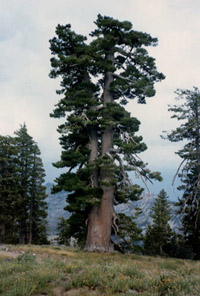Sierra trees dying at alarming rate as climate warms
Conifer trees in the Sierra Nevada are dying at nearly double the rate as they were two decades ago, stressed by hotter temperatures and lower precipitation, according to a study to be presented later this week.

The 400-mile(644-kilometer)-long range has endured dry spells in the past, but its trees now are more likely to die during such periods because they are struggling with the effects of a new challenge - global warming.
"What surprised us are how sensitive these trees are to short-term changes in climate," said Phillip van Mantgem, an ecologist with the U.S. Geological Survey and author of the report. "That was kind of a shock."
Geological Survey researchers will present their findings Friday at a meeting of the Ecological Society of America in San Jose, California. They say their report is the first of its kind, coming after researchers spent 22 years examining coniferous trees in Yosemite and Sequoia national parks.
While some trees have grown faster in other parts of the U.S., the USGS researchers found the opposite to be true in the Sierra.
The study, begun in 1983, examined 21,338 trees in a variety of forests - ponderosa pine-mixed conifer, white fir-mixed conifer, red fir, Jeffrey pine and subalpine.
During the study period, the average mortality rate increased every year by about 3 percent, leading to a near doubling of the rate by the end of the period.
Most of the dying trees were smaller with younger and shallower root systems and thus had less capacity to store water that could sustain them during droughts. They tended to be at lower elevations where temperatures are warmer and they were more susceptible to insect and fungal infestations.
"We looked at all the different forest types, and so what we were seeing was not an anomaly to one species," van Mantgem said. "There's probably something generally going on. Something broad scale."
The researchers excluded areas that had never been logged or burned by fire since the 1800s.
They said the study was the first to analyze temperate forests in such detail. Its results add to the growing consensus that forests across the globe are changing as the Earth warms.
It also could help explain the widespread tree die-offs in forests throughout the western United States over the last few decades. Researchers cautioned that more data was needed about other forests before they could draw conclusions.
Still, the Sierra forests share similarities with others in the West because they grow in climates of hot, dry summers and typically cool, wet winters.
In the Southern California mountains, millions of trees have died over the past decade because of drought and insect infestation, largely from the bark beetle.
The Geological Survey researchers found that the trees in the Sierra also died largely from insects and other stresses, in part because there is less water than 20 years ago.
During the 22-year study, the Sierra Nevada warmed by 1.8 degrees Fahrenheit (-17 Celsius), while the amount of snowfall or rain remained the same. Some of that precipitation evaporated as the climate warmed instead of being absorbed by the trees, van Mantgem said.
"Some of these systems might be more fragile than they appear," he said.
Subscribe to Pravda.Ru Telegram channel, Facebook, RSS!




